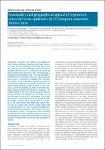Seasonality and geographical spread of respiratory syncytial virus epidemics in 15 European countries, 2010 to 2016
Broberg, Eeva K.
Waris, Matti
Johansen, Kari
Snacken, René
Penttinen, Pasi
European Influenza Surveillance Network
Respiratory syncytial virus (RSV) is considered the major pathogen causing severe lower respiratory tract infections among infants and young children [1]. RSV is the most common cause of hospitalisation for acute lower respiratory tract infection in children younger than 5 years and is estimated to cause between 66,000 and 199,000 deaths worldwide every year [2]. Its significance in causing substantial morbidity and hospitalisation in the first year of life has been affirmed in a recent study and a meta-analysis [3,4]. In England, average annual hospital admission rates are 35.1 per 1,000 children younger than 1 year and 5.31 per 1,000 children aged 1–4 years [5]. In addition to children, RSV causes a substantial disease burden in elderly people and patients with chronic obstructive pulmonary disease [6,7].
RSV causes seasonal epidemics worldwide [8], with one to two epidemics each year [9] following latitudinal gradients in timing, duration, seasonal amplitude and between-year variability [8,9]. In some studies, the seasonal periodicity has been connected to climatic factors [9-11], but a common factor that explains all observed periodicity has not been established. Meteorological conditions such as temperature and high relative humidity have been reported as important predictors of RSV epidemics [9,12]. In the United States (US) and Japan, annual national and regional variation of RSV season onset and end has been reported [13-15]. In the Nordic countries, a major outbreak often alternates with a minor one, with the minor peak in the spring and a major one the following winter [16-19], a phenomenon reported also in Croatia [20], Denmark [21] and Germany [22]. RSV antigenic groups A and B alternate in two-year cycles in Finland, with dominance of the group A viruses in years 1981–82, 1985–86 and 1989–90 and the group B viruses 1983–84 and 1987–88 [17,19], and different genotypes dominate the circulation in consecutive epidemics in Korea [23]. In Spain, no biennial rhythm has been detected but rather a stable annual epidemic with a peak between week 52 and week 1 and circulation 2–8 weeks earlier than influenza viruses [24]. Similarly, in the United Kingdom (UK), one stable epidemic per year is observed [5].
Immunoprophylaxis to prevent RSV infection with a neutralising monoclonal antibody, palivizumab, has been developed for administration to target groups on a monthly basis during the RSV season [25]. However, this drug is limited to high-risk infants, the cost prohibits its use in low- and middle-income countries and the data on effectiveness of the drug in children at high risk other than infants born at gestational age < 33 weeks and in children with chronic lung and heart diseases are limited [26]. The demonstrated high disease burden of RSV infection has created a longstanding interest in RSV vaccines. Approximately 60 RSV vaccine candidates are in preclinical to phase III clinical trials [27,28], with potential target groups including elderly people, pregnant women and infants. A vaccine is expected to enter the market within 5–10 years, presumably by 2025 [29]. As natural infection provides only limited protective immunity owing to evolution of the surface protein G and alternating dominance of antigenic groups A and B [30], most of the vaccine candidates target the fusion protein F, which is cross-reactive across RSV subtypes [27]. To circumvent issues with alternating strains, it has been also suggested to consider inclusion of both RSV A and B in a future RSV vaccine [30]. To plan optimal future vaccination strategies, it is critically important to understand who is affected by RSV and to identify which groups are at risk of more severe RSV infection requiring hospitalisation or intensive care. RSV infection is not notifiable in the European Union (EU) and European Economic Area (EEA), except in Ireland, but many countries have a long tradition of reporting laboratory-confirmed RSV infections at national and international level. The European Influenza Surveillance Network (EISN) collects RSV data for the purpose of interpreting the reports of influenza-like-illness (ILI); these data can also be used to analyse seasonality of RSV [31].
Inter-country comparative analysis of seasonal circulation of RSV across Europe is lacking as most of the published literature focuses on individual countries. Our study describes the seasonality of RSV in 15 countries in the EU/EEA, specifically the start and peak of the season, length of the season and geographical spread, as a baseline description of RSV circulation in Europe. We further aimed to test if the data reported through influenza surveillance systems in use in EU/EEA countries are appropriate to analyse RSV seasonality, including more countries and a more detailed analysis than previous studies.
Dateien zu dieser Publikation

